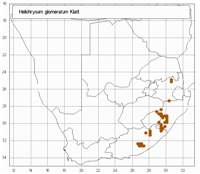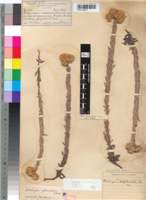Origin of name:
glomeratus /-a/-um = clustered in rounded heads
Diagnostic characters:
Compact branched flower headsYellow bractsVery short inflorescence stalkGrey hairy leaves pressed to stems
Description:
A rhizomatous perennial herb, stems solitary or 2 to 3 together, erect to c. 450 mm, commonly simple, rarely forking, loosely grey-cottony, densely leafy. Radical leaves (seldom represented in herbaria) rosetted, spreading, up to 30 x 10 mm, lanceolate, apex acute to very acute, base broad, half-clasping, both surfaces enveloped in silvery silky, rather 'stringy' indumentum, rarely woolly-felted; cauline leaves similar but smaller (up to 20 x 8 mm), not decreasing in size upwards, erect, closely imbricate. Heads homogamous, cylindric, 3-4 x 1-1.5 mm, very many in congested, roundish, corymbose clusters matted together with wool at the base, these in turn congested (but not matted) in a flattish corymbose cyme 20-50 mm across. Involucral bracts in c. 4 series, graded, imbricate, outer brownish, inner tipped bright canary-yellow, about equaling flowers, not radiating, translucent or sub-opaque. Receptacle with pit margins slightly produced. Flowers 5-6, yellow. Achenes not seen, ovaries glabrous. Pappus bristles c. 6, tips shortly plumose, bases nude, not cohering.
Flowering between February and May, but mainly in March and April.
Distribution:
Often in large colonies in open grassland. From Lydenburg in the E. highlands of Mpumalanga south to the Free State around Harrismith and Witsieshoek, the Midlands and Uplands of KwaZulu-Natal, East Griqualand and the Transkei to the Amatola Mountains in the E. Cape.
Grassland Biome.
Taxonomy:
Literature:
Helichrysum glomeratum Klatt in Bull. Herbarium Boissier 4: 460 (1896); Moeser in Bot. Jb. 44: 249 (1910); Hilliard, Compositae in Natal 159 (1977).
Type:
Lectotype: KwaZulu-Natal, East Griqualand, grassy, stony places on Malowe Mt, 4500 ft, Tyson 740 (Z; BM; BOL; K; SAM; UPS, isolecto.).
Synonym(s):
Vouchers:
Hilliard & Burtt 6549 (E; K; MO; NU; PRE); Wright 137 (E; M; NU).


